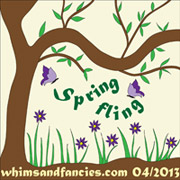Welcome to the opening day of Soma's Spring Fling Blog Hop! I am honored to be the first facilitator here on April Fool's Day! But I am not foolin'! I have seen some of the designs and you are going to have fun this month.
This little girl is walking in the rain right after a spring shower. I could not locate a green solid for her boots, so I simply decided to let her totally 'rock the dots' (like a little girl might dress herself.)
For complete instructions and tutorial for this block, click on the rainbow below, download and print the .PDF:
- In the .PDF file, on Page 2&3, I've included some changes or "short cuts" you might use to simplify making the design (just FYI, the design won't be quite as definitive, but works just fine).
- Want to try a new paper-piecing method? This is the one I use with freezer paper. You can reuse your pattern because it's not torn up!
- Here are a few tips that might help you as you go:
 |
| this tip also works when aligning seams, as well |
- Here's how to make the girlie's braids from embroidery floss.
- Select a skein of embroidery floss that is the color you want for ponytail(s) and remove wrappers. Untwist the floss.
- At one end, snip though all threads of the skein.
- In the middle of the strands, lay the threads out flat. Find the middle and sew across the flattened threads ½” from the center spot.
- Cut the two sections apart between the two sewn spots to make to pieces.
- To braid, divide the threads in three even strands of floss.
- Braid them loose at the top (near the seams) and tighter toward the end.
- Line up the block's Umbrella Section and Girl Section. Hold your braids up to the block to decide how long (or short?) they should be.
- Put a dot of glue at the spot you will be tying the bow.
- Tie your ribbon on the end of the braid in your preferred fashion
- Trim the ends of the pony tails.
- Position your ponytails in the seam between the finished umbrella and girl block sections.
- Carefully pin the fabric and braids in place.
- You are ready to sew these two sections together, with the braids sandwiched between them.
I hope you enjoy piecing this little block! It was fun picking out the "rock the dots" prints for the rain attire. The cloud background is a little busy and dark. Next time, I might use a slightly mottled aqua, blue or light gray batik.
The rainbow lets us know that the clouds are parting and the sun is beginning to shine... shine all the way past the May flowers to warmer weather and summer!
If you have ANY problems at all with this design, please email me and I will get back to you as soon as I can.
===========================================================
There are at least TWO GIVE-AWAYS! this month...
PART ONE--MY Give-away: Today, you have three chances to win this prize:
 |
| from Jenny at Sublime Stitching |
- Subscribe to my blog, then leave a comment telling me your favorite thing about spring or paper-piecing (I know some of you have allergies *ah-choo!* and bless you!)
- Post the Button and a link to the Soma's Spring Fling Blog Hop on your blog, then leave yourself another comment HERE.
- Tweet, tweet tweet about my blog and my block kicking off the Spring Fling Blog Hop. Add a 3rd comment and chance to win!

TeriEmerson.com
 |
| http://www.whimsandfancies.com/category/spring-fling/ |
On Monday, April 8, Randy N. Generator will choose a winner for this spectacular kit from Sublime Stitching.
But WAIT ~ That's not all! Soma's having other drawings (I know this bundle will be offered at the end of the month.
Pop over to Soma's place to see what's happening there. You can also see the list of bloggers that will be bringing you free paper-pieced patterns and other goodies throughout the month of April.
Pop over to Soma's place to see what's happening there. You can also see the list of bloggers that will be bringing you free paper-pieced patterns and other goodies throughout the month of April.
Happy Sewing!
Happy SpRiNg!!!















